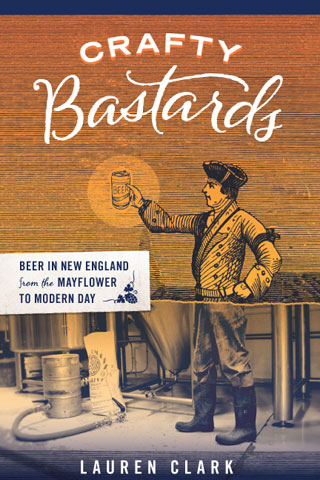Archive for the ‘Brandy’ Category
January 29th, 2009
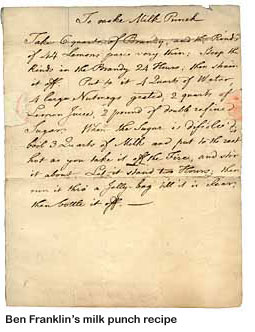 It’s one of the oddest drinks I’ve ever tasted. And I mean that in a good way. I first had milk punch (not to be confused with the simpler concoction of brandy, rum or bourbon, sugar, whole milk and nutmeg served over crushed ice) at a Stir class last winter. It was sweet, velvety, rich … and confusing. That’s because, though it’s made with milk, it’s somewhere between translucent and transparent. In other words, not at all “milky.” Leave it to the bartenders at Drink to reintroduce this punch, which takes two days to make, to the modern imbiber. I write a short introduction to one of their recipes, Rum-Hibiscus Milk Punch, in today’s online Globe.
It’s one of the oddest drinks I’ve ever tasted. And I mean that in a good way. I first had milk punch (not to be confused with the simpler concoction of brandy, rum or bourbon, sugar, whole milk and nutmeg served over crushed ice) at a Stir class last winter. It was sweet, velvety, rich … and confusing. That’s because, though it’s made with milk, it’s somewhere between translucent and transparent. In other words, not at all “milky.” Leave it to the bartenders at Drink to reintroduce this punch, which takes two days to make, to the modern imbiber. I write a short introduction to one of their recipes, Rum-Hibiscus Milk Punch, in today’s online Globe.
There are many variations on the basic milk punch recipe. The drinkboston punch party at Eastern Standard in June featured Milk Punch No. 1 from the Savoy Cocktail Book. Aphra Behn, a 17th-century English dramatist and novelist and allegedly the first woman to make a living as a writer, is credited with inventing milk punch, or at least having the first widely publicized recipe for it. Whatever its origins, it became well known enough during the 18th century for Benjamin Franklin to share a recipe for milk punch with James Bowdoin during his 1763 stay in Boston.
“Franklin’s Milk Punch recipe shares characteristics of two types of beverages — possets and syllabubs,” according to the Massachusetts Historical Society.
Wow. I am so looking forward to walking into a Boston bar and ordering possets and syllabubs.
Tags: Boston Globe, milk punch
Posted in Brandy, Cocktails, drinkboston in the news, Punch, Rum | 9 Comments »
July 2nd, 2008

If Monday night’s Flowing Bowl Punch Party, hosted by drinkboston at Eastern Standard, were a high-diving competition, it would score a perfect 10 for both execution and technical difficulty. I mean, how often do you walk into a bar and see 60-odd people holding decorative cups filled with punch made from 200-year-old recipes? How often are you served a drink that involves steeping three kinds of booze, multiple fruits and spices and green tea in hot water for several hours, adding milk, straining the curdled mixture through cheesecloth twice and chilling the finished product down with a massive ring of ice decorated with pineapple slices? And how often do you see bartenders ladling liquid out of large, flowing bowls instead of shaking cocktails?
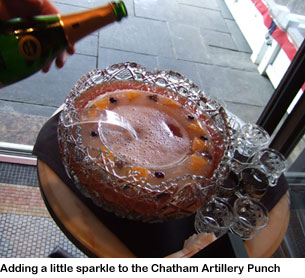
Thanks to Jackson Cannon and Tom Schlesinger-Guidelli for concocting the four punches — all deceptively potent and enjoyably distinct from one another — from recipes in David Wondrich’s Imbibe!, the Savoy Cocktail Book and Martha Washington’s own notebook. And thanks to the rest of Eastern Standard’s staff for the charcuterie, deviled eggs, beef carpaccio and other tasty bites, and the gracious service.
Below is a list of the punches that were served, along with their key ingredients and bits of historical poetry revealing that odes to alcoholic beverages in America existed well before the Algonquin Round Table. To create these punches yourself, either consult the aforementioned sources or click on the links below.

Philadelphia Fish-House Punch
Toast of Schuylkill and to Independence!
Lemon juice
Cane sugar
Mixture of cognac, rum and house-made peach brandy
Cold water
Created by a colonial rod and gun club on the banks of Pennsylvania’s Schuykill River and remembered in modern times thanks to a recipe passed on by a Philadelphia lawyer, Charles Godfrey Leland.
“There’s a little place just out of town,
Where, if you go to lunch,
They’ll make you forget your mother-in-law
With a drink called Fish-House Punch.”
Martha Washington’s Rum Punch
Cheers to our first First Lady!
Juice of lemons & oranges
Spice mix of clove, cinnamon & nutmeg
Oranges
Curacao, light & dark rums
Water
This recipe is said to have come from Martha Washington’s own journal.
“This ancient Silver bowl of mine, it tells of good old times,
Of joyous days, and jolly nights and merry Christmas Chimes
They were a free and jovial race, but honest, brave and true,
That dipped their ladle in the punch when this old bowl was new.”

Chatham Artillery Punch
For soldiers young and old, men of action, brave and bold!
Pineapples, lemons, oranges & cherries
Native wine, rum & rye
Cherry nectar
Strong green tea & champagne
The house punch of the Chatham Artillery of Savannah, Georgia, formed in 1786. Recipe available in Imbibe!
“When you visit the town of Savannah
Enlist ‘neath the temperance banneh,
For if you should lunch,
On artillery punch,
It will treat you in sorrowful manneh.”
Milk Punch #1
Celebrate the wit and wisdom of Aphra Behn.
Juice and rind of lemons
Pineapple
Spice mix of clove, coriander, cinnamon & green cardamom
Brandy, rum & batavia arrack
Strong green tea, water & milk
Aphra Behn was a 17th-century English dramatist and novelist and the “first woman ever to earn her living solely by writing,” according to Imbibe! She is also credited with inventing milk punch, a drink that is “undeniably smooth, but not necessarily lush,” writes Wondrich. This recipe is the Milk Punch #1 from the Savoy Cocktail Book.
“If all be true that I do think,
There are five reasons we should drink;
Good Punch, a friend, or being dry
Or least we should be by and by,
Or any other reason why!”
Tags: chatham artillery punch, martha washington's rum punch, philadelphia fish-house punch, savoy's milk punch no. 1
Posted in Brandy, Events, Punch, Rum, Whiskey | 11 Comments »
July 10th, 2007
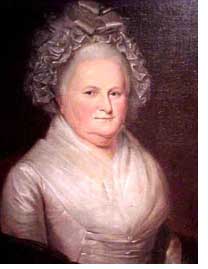 I was lucky enough to be present at a July 4 roofdeck party where Misty Kalkofen appropriately brought along a batch of Martha Washington Rum Punch. The stuff was to be admired on principle alone; picture our first First Lady serving the mixture to dignitaries at Mt. Vernon, probably using rum from the estate’s own distillery(!). Give it up for Martha and that badass husband of hers. But the punch didn’t just get by on its historic coolness. It was actually delicious. Misty writes about Martha and her punch, as well as re-creates the recipe, on the LUPEC-Boston blog. (For convenience’s sake, I’ve copied the recipe below. Frankly, I would call the grated cinnamon and nutmeg on the finished drink optional.) When I heard “nutmeg, cinnamon and cloves,” I thought, ‘Uh-oh, this is going to taste weirdly wintry.’ But the flavors of the spices, juices and rum were perfectly melded together to create an almost tea-like iced drink that was a thing unto itself — a dangerous thing unto itself, since it didn’t taste anywhere near boozy as it is.
I was lucky enough to be present at a July 4 roofdeck party where Misty Kalkofen appropriately brought along a batch of Martha Washington Rum Punch. The stuff was to be admired on principle alone; picture our first First Lady serving the mixture to dignitaries at Mt. Vernon, probably using rum from the estate’s own distillery(!). Give it up for Martha and that badass husband of hers. But the punch didn’t just get by on its historic coolness. It was actually delicious. Misty writes about Martha and her punch, as well as re-creates the recipe, on the LUPEC-Boston blog. (For convenience’s sake, I’ve copied the recipe below. Frankly, I would call the grated cinnamon and nutmeg on the finished drink optional.) When I heard “nutmeg, cinnamon and cloves,” I thought, ‘Uh-oh, this is going to taste weirdly wintry.’ But the flavors of the spices, juices and rum were perfectly melded together to create an almost tea-like iced drink that was a thing unto itself — a dangerous thing unto itself, since it didn’t taste anywhere near boozy as it is.
Martha Washington’s Rum Punch
4 oz lemon juice
4 oz orange juice
4 oz simple syrup
3 lemons quartered
1 orange quartered
1/2 tsp grated nutmeg
3 cinnamon sticks broken
6 cloves
12 oz boiling water
In a container mash the lemons, orange, nutmeg, cinnamon sticks and cloves. Add syrup, lemon and orange juice. Pour the boiling water over the mixture. Let it cool. Strain out the solids. Heat the juice mixture to a boil and simmer for 10 minutes. Let it cool and refrigerate over night.
In a punch bowl combine:
3 parts juice mixture
1 part light rum
1 part dark rum
1/2 part orange curacao
Serve the punch over ice. Top with grated nutmeg and cinnamon.
Champagne Juleps were simply something I discovered on cocktaildb.com. I happened to have a bottle of pretty good champagne on hand, plus a tall, vintage glass pitcher, and I wanted to serve a crowd-pleasing, summery cocktail to some dinner guests. Champagne Juleps were the answer. These are essentially Mojitos made with brandy and sparkling wine instead of rum and soda water, and served over crushed ice. I saw one of my guests the following night, and — mind you this guy rarely veers out of Guinness-and-Jameson territory — he said, “I can’t stop thinking about Champagne Juleps.” They were quite tasty if may say so myself. Here’s the cocktaildb.com recipe, followed by my modifications.
Champagne Julep
Build, fill glass 1/2 with crushed ice
1 1/2 oz brandy
1 tsp sugar, muddle with several mint sprigs in a splash of water (4 dashes)
Fill with Champagne
Add mint sprigs
Serve in a double rocks glass (12.0 oz)
I used superfine sugar, and a little more than half of the amount called for, which made the drink plenty sweet. I also only used about 2 mint leaves per serving. Since I was using a pitcher, I muddled the sugar, water and mint right in there, then added the brandy and stirred. The 40-lb bag of crushed ice I bought at Acme Ice was overkill, but I stuffed the rest of it in the freezer for future summer libations.
Posted in Brandy, Champagne, Cocktails, Rum | 5 Comments »
March 6th, 2007
When Esquire drinks writer David Wondrich made a guest appearance behind the bar at Eastern Standard a couple of weeks ago, he mixed a drink I’d never had before: the Saratoga. Equal parts cognac, rye and sweet vermouth, the Saratoga is one of those cocktails that flies in the face of the number-one rule you were taught during your formative drinking years: do not mix your spirits. Cognac and rye? Mixed together in the same glass? Run and hide!
No, don’t. Try it. It’s one of those drinks whose seemingly simple ingredients and proportions form something eye-openingly new. Here’s the recipe, along with the brands of liquor Wondrich used that evening. Note: he colored outside the lines with the bitters he used — a Peruvian brand that Eastern Standard happened to have lying around. They were a bit funky.
Saratoga Cocktail
1 oz cognac (Hine)
1 oz rye (Rittenhouse 100-Proof)
1 oz sweet vermouth (Martini & Rossi)
2 dashes Angostura bitters or other aromatic bitters, such as Fee’s Old-Fashioned
Stir well with ice. Strain into chilled cocktail glass and twist a lemon peel over the top.
If you order this in a bar, be sure to specify that it’s the above version you want. There are several other cocktails named Saratoga, and they tend to involve maraschino liqueur and/or pineapple syrup.
Posted in Brandy, Cocktails, Vermouth, Whiskey | 1 Comment »
February 14th, 2007
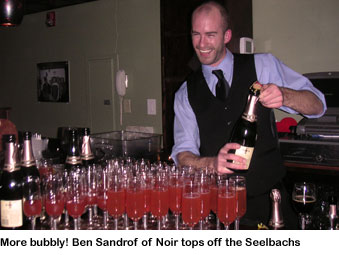
What better way to spend a Monday night in February than at a cozy neighborhood restaurant drinking champagne cocktails mixed by some of Boston’s best bartenders? That’s the sound reasoning that brought 60+ people to Green Street last night for drinkboston.com’s sold-out champagne cocktail party. Misty Kalkofen of Green Street and the B-Side Lounge, Ben Sandrof of Noir, Dylan Black of Green Street and John Gertsen of No. 9 Park mixed four distinctive classic cocktails using champagne: the Diamond Fizz, the Black Velvet, the B2C2 and the Seelbach (recipes below). Not only that, they visited each and every table in the room, explaining the drinks’ origins (or alleged origins, given that the history of cocktails is usually as unverifiable as the provenance of traditional folk songs). The evening was festive and informative — well worth the price of a small headache on Tuesday morning.
To get on the email list for future drinkboston.com events, email drinkboston at comcast dot net.
 The cocktails
The cocktails
B2C2
1 oz each of brandy, Benedictine and Cointreau shaken over ice and strained. Top with champagne.
Misty learned of this drink from David Wondrich’s Killer Cocktails: An Intoxicating Guide to Sophisticated Drinking. It was “created by American intelligence officers at the end of WWII. They had all of these wonderful goods that had been looted from the French by the Germans and then left behind during the Germans’ retreat,” she says. Luxurious bubbles.
Diamond Fizz
2 oz gin, 1 oz lemon juice and 1/2 tsp powdered sugar shaken over ice and strained. Top with champagne.
A dressed-up gin fizz (which uses seltzer instead of champagne). Also similar to the French 75, only it contains less sugar and no garnish. The Cocktail Database recipe calls for a highball glass with ice, but we served it straight up in a saucer. Delicious either way.
Black Velvet
1/2 stout and 1/2 champagne in a wine glass or flute.
Said to have been created at London’s Brooks Club in 1861 during mourning over Prince Albert’s death. Also called the Bismarck, as the drink was a favorite of German statesman Otto von Bismarck. Dylan used Mackeson’s Stout for this drink. Dark and rich.
Seelbach
1 oz bourbon, 1/2 oz Cointreau and 7 dashes each Angostura and Peychaud’s bitters poured into a flute and stirred. Top with champagne.
Invented at the Seelbach Hotel in Louisville, Kentucky, circa 1917. The recipe was lost, probably during Prohibition, until being rediscovered by the hotel in 1995 and later printed in Gary and Mardee Regan’s New Classic Cocktails. This is one of the great whiskey drinks.
Posted in Bartenders, Beer, Brandy, Champagne, Cocktails, Events, Gin, Liqueur | No Comments »
 It’s one of the oddest drinks I’ve ever tasted. And I mean that in a good way. I first had milk punch (not to be confused with the simpler concoction of brandy, rum or bourbon, sugar, whole milk and nutmeg served over crushed ice) at a Stir class last winter. It was sweet, velvety, rich … and confusing. That’s because, though it’s made with milk, it’s somewhere between translucent and transparent. In other words, not at all “milky.” Leave it to the bartenders at Drink to reintroduce this punch, which takes two days to make, to the modern imbiber. I write a short introduction to one of their recipes, Rum-Hibiscus Milk Punch, in today’s online Globe.
It’s one of the oddest drinks I’ve ever tasted. And I mean that in a good way. I first had milk punch (not to be confused with the simpler concoction of brandy, rum or bourbon, sugar, whole milk and nutmeg served over crushed ice) at a Stir class last winter. It was sweet, velvety, rich … and confusing. That’s because, though it’s made with milk, it’s somewhere between translucent and transparent. In other words, not at all “milky.” Leave it to the bartenders at Drink to reintroduce this punch, which takes two days to make, to the modern imbiber. I write a short introduction to one of their recipes, Rum-Hibiscus Milk Punch, in today’s online Globe.



 I was lucky enough to be present at a July 4 roofdeck party where
I was lucky enough to be present at a July 4 roofdeck party where 
 The cocktails
The cocktails